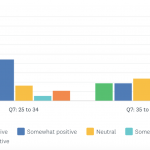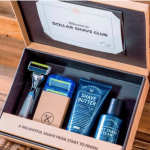How to perform product positioning
Learn how to give your products quality marketing messages that land the right audience.
Product positioning is the process of determining the best ways to market and sell a product. It considers user feedback on your product features, the attributes of your target audience, and the characteristics of competing products.
We’ll walk you through how to position any type of product and how other companies have done it. But first, we’ll give you more context on why it’s important.
What is product positioning?
Let's define what we mean by product positioning—it’s a strategic exercise that helps you to understand where in the marketplace your products and services fit, and how they are differentiated from alternatives and substitutes. It outlines all of the features and characteristics that make your product unique. Think of product positioning as the first step on the road to your marketing journey. If you know that you want your product to be seen as more luxurious, better quality, or more affordable than its competitors, you’ll have a sound foundation for crafting your marketing materials, assets, and messages.
Need respondents to help you with product positioning research?
SurveyMonkey Audience has a trusted panel of survey respondents from across the globe, ready to tell you what they think.
Why product positioning matters
Only 5% of products launch successfully. Why? In the Harvard Business Review, Joan Schneider and Julie Hall explain: “The biggest problem we’ve encountered is lack of preparation: Companies are so focused on designing and manufacturing new products that they postpone the hard work of getting ready to market them until too late in the game.”
In other words, you need to do your research. The product positioning process forces you to by asking the tough questions that pressure test your messaging and target audience.
Here are just some of the questions you’ll want to get answered:
- Why is our product valuable?
- Which product features are more impactful than others?
- Who finds our product valuable?
- Do particular groups find our product useful for different reasons?
- Who are our top competitors?
- What are our product’s relative strengths and weaknesses?
The insights you receive in each of these areas will give your product the best chance at success.
Advantages of product positioning
If you’re clear about where your product fits in the marketplace, you can expect to realize a number of benefits. Let’s take a look at a few:
Identifying benefits of a product and matching them with customer needs
Remember: it's almost impossible to satisfy the needs of all customers, all of the time, using a one-size-fits-all strategy. That’s why one of the keys to resonate with customers is to segment your market, identify the distinct characteristics and needs of each segment, and then tailor your product and marketing mix in a way that each segment finds valuable. Product positioning can actually involve multiple layers. For example, you might position your cruelty-free, luxury handbags as sustainable to satisfy customers who place a high value on eco-goods, or as affordable luxury for a mid-range segment.
Check out our market research product survey.
Finding a competitive advantage
In modern marketplaces, customers are overwhelmed with choice. In order to entice custom, you’ll need to stand out from the pack. Performing product positioning will help you understand what makes your products or services unique—and you can use this information as the basis for future marketing campaigns.
Meeting customer expectations
Customer dissatisfaction happens when customers perceive that you’ve failed to deliver on your value proposition. But, what if what customers expect and what you plan to deliver are actually wildly different? Product positioning helps you to meet customer expectations by understanding what they want, and ensuring that your brand promise is aligned.
Learn how to keep your customers happy with customer satisfaction surveys.
Reinforcing brand name and products
Brand names are a crucial part of any competitive differentiation and sales strategy. But, the way in which brand names become ‘sticky’, or memorable in the mind of customers is through a cognitive association that the customer creates between the brand and a standout feature. Think Apple, and you think innovative. Gucci conjures up images of prestige, while Volvo evokes a sense of reliability. Product positioning can help reinforce your brand and make it memorable to customers and other stakeholders.
Find out where your brand stands with Brand Tracking Solutions.
Increasing customer loyalty
Product positioning can also help cultivate customer loyalty by giving customers the sense that the key characteristics associated with your brand can’t be found elsewhere. But, this only works if you keep your brand promises: if you position your product as reliable and it continually fails to work, customers will quickly vote with their feet.
Learn how to improve customer loyalty and retention.
Attracting different customers
Since products can be positioned differently across multiple axes of features, you can attract a diverse range of customers. A high-quality, sustainable, yet affordable product might, for instance, appeal to three different segments of customers, all of whom have different priorities. Being able to appeal to a diverse customer base can drive sales and improve your market dominance.
Get insights on your industry as a whole with our Industry Tracker.
New product development
Product positioning is also vital when it comes to developing new products, which don’t yet have an identity. It can help you to understand where gaps in the marketplace exist - gaps that can be capitalized upon to capture new segments and drive sales.
Presenting new features of existing products
As well as helping you to figure out where new products should be positioned, product positioning exercises help you identify characteristics of existing products that you didn’t previously know were valued by customers.
Developing a product positioning strategy
So, now you know the myriad benefits of performing product positioning, how do you go about it? In this section, we’ll talk you through how to create a product positioning strategy in just 3 steps.
Understand the customer
You might think that effective positioning of a product or service starts with understanding the product, but that’s not the case. Instead, you’ll need to think about what customers want, need, and how they’re currently not being served if you’re to create a viable and successful product positioning strategy. In the first instance, find out who your customers (and prospective customers) are. What do they look like? Where, what, and how do they buy? And, most importantly—what do they value? This will help you figure out how best to satisfy their needs.
Conduct market research
Next, conduct market research with your customers. In general, you’ll want to assess the competitive landscape, as well as your customers. In other words, find out what similar products and services are already out there, and how they’re positioning themselves. Find out whether those strategies resonate with customers, and whether they have any unmet needs. And find out more about your customers, such as their demographics, psychographics, and lifestyles.
Assess the product
Finally, assess the product and determine whether it can be positioned to meet customer needs in a way that will be successful. You might need to make tweaks to the product itself, or to your marketing strategy. For example, pricing might need to be changed, or you may need to adopt a new approach to product promotions. All aspects of the marketing mix should be designed in such a way as to reinforce the position in the market that you’ve selected.
Types of product positioning strategies
Once you’ve gathered all your data, you’ll be in a position to develop the positioning strategy that works best for your customer and for your product. There are a few different types of positioning strategies that are commonly used.
- Price: One of the most common positioning strategies. Typically, businesses position their goods at a specific place along a price continuum ranging from low, through to medium and high.
- Quality: Often used alongside pricing positioning strategies, with high quality products typically being priced at a higher price point than lower quality products.
- User strategy: Focuses on the different needs of different segments of consumers. Technology products are often positioned in this way. For example, some pieces of Adobe software are targeted especially for coders and creative users, while others are positioned for everyday users.
- Product type: Similarly, products can be categorized into different types in order to appeal to different categories of users. Coca-Cola, for instance, offers flavored and sugar-free versions of its main product to appeal to different market segments.
- Competition: Some positioning strategies aggressively position products as being able to outperform named competitors on features of value to customers like speed or innovation.
- Differentiation: A differentiation strategy positions a product or service as completely unique from all other products on the market.
How to conduct product positioning research
Now that you know why it matters, let’s talk about how you can collect—and use—data that helps you position your product.
Decide how to gather your feedback
Before you gather feedback, carefully consider each of your options. Let’s take a look at some of the options available to you along with the pros and cons of each.
Surveys
Pros
- You can reach a wide range of consumers cost-effectively and quickly.
- Taking the survey can be a small ask for consumers, as they can answer the questions wherever they’d like in a matter of minutes.
- It’s easy to organize and analyze the responses that come in.
Cons
- You won’t be able to gather as in-depth feedback as you would with a focus group or a 1:1 interview.
- You can’t experience people’s reactions in person.
Focus groups
Pros
- You’ll be able to gather in-depth feedback.
- You’ll have a chance to gather feedback from several consumers
Cons
- It can be expensive to organize and gather several individuals.
- You might not be able to recruit consumers from certain backgrounds.
- It can be difficult to hold sessions consistently over time because of logistics or expenses.
Individual interviews
Pros
- You can gather more comprehensive feedback than the alternative approaches.
- You can more effectively build trust and credibility with your target audience (as you’re spending more quality time with each of them).
Cons
- It’s the most expensive option out of the 3
- It will be near-impossible to get feedback from a diverse set of consumers.
- It may not be financially sustainable.
Product positioning surveys
Let’s move on to take a look at product positioning surveys, their advantages, and how to conduct them. Product positioning surveys are surveys that measure or capture the position of a product or service relative to competitors. It can help you understand what customers think about your product, and whether your intended positioning is being received by customers.
Advantages of product positioning surveys
Product positioning surveys can help you to:
Identify primary decision-makers
These are the individuals who make purchasing decisions on behalf of the household. Figure out how those people are, and what they want, and you’ll be on your way to being able to craft marketing messages that resonate with them.
Measure brand awareness
Positioning surveys usually ask respondents to compare competing products on relevant characteristics. For example, respondents might be asked which of a number of products is more reliable or trendier. Asking questions like these, by extension, will give you insight into how well known your brand is.
Measure brand perception and sentiment
Positioning surveys also help you understand how your brand is perceived by customers because your products and services are key components of the brand.
Identify strengths and weaknesses compared to the competition
Comparison questions will give you great insight into the features of your product that customers perceive as stronger or weaker than alternatives on the market.
Product positioning survey tips
Assuming you decide on using a survey, here are 4 best practices to consider:
1. Organize your questions thoughtfully to ensure you gather quality responses.
Since you’re reaching people who may not be familiar with your product, it can be useful to introduce it at the beginning. For example, use an intro page that includes an image of the product and a few sentences that describe it.

The questions that follow should be ordered by topic. Questions specific to your product should follow each other on a single page; while questions about alternative products should also be grouped together on another page.
For help on the specific questions you can ask, check out our product survey template.
Related: How to engage in product packaging testing
2. Ask your questions to a diverse set of consumers—people of all ages, occupations, and backgrounds. Be especially attentive to any demographics that you want to market to.
3. Analyze your responses carefully so you can arrive at an effective product positioning statement.
Learn more about how you can create charts from your survey responses.
Then review the responses from your open-ended questions (those that don’t include answer options—like comment boxes). You can look at the responses through word clouds to quickly understand how respondents feel about your product, and read through individual responses for more detail.
For example, here’s a vertical bar chart that compares two age groups’ responses to the question, “What is your first reaction to the product?”

Once you feel like you understand how different types of consumers feel about your product, you’re ready to start developing a product positioning statement. The statement should concisely explain how your product meets your target audience’s needs—based on your research. Your colleagues in marketing and sales can then use the statement as a reference point for keeping the product’s message on point and for targeting the right people.
To save you time in coming up with your own product positioning statement, you can use the following formula:
For (your audience) who (insert need), (your company) can (insert benefit). And unlike competitors, (your company) can (insert competitive differentiation).
4. Don’t let the product positioning process end.
Your target audience’s needs and perceptions will change over time. To keep up, your product positioning strategy should include an annual round of product feedback.
Note: You may need to collect feedback bi-annually if there have been significant changes to your product and its impact on your target audience.
This is one of the reasons why surveys are a great option for running product positioning studies. They can automatically go out at particular time intervals, offer the flexibility of gathering feedback quickly and affordably, and allow you to easily compare the responses from previous studies.
Example questions
Examples of questions you might ask in a product positioning survey include:
- Which of the following factors are most important when deciding to make a purchase?
- Thinking about [example industry / product], what brand name comes to mind first?
- Which of the following products do you think is the most reliable?
- Which of the following products do you associate with affordability?
Product positioning examples
What does product positioning actually look like? Here are 3 real-world product positioning examples you can learn from:
1. Tesla isn’t the first company to manufacture electric vehicles, but they’ve found success by marketing to environmentally-conscious, middle-to-high income households who value a car’s aesthetics and driving capabilities.

2. Simple offers banking services through its clean, simple, and intuitive app. To stand out, they’ve targeted busy young professionals who don’t usually want to visit a bank in-person or deal with a poorly designed site or app.

3. Dollar Shave Club mails customers a variety of shower and shaving supplies on a recurring basis. They differentiate through convenience—customers don’t want to spend time and mental energy on shopping for quality products.

Now that you know how to perform product positioning and have tangible examples to pull from, you’re ready to scope out the ways to market and sell your own products. And if you’d like us to help, we have a range of solutions - like our tailored messaging and claims analysis solution. Reach out today!
Discover more resources

Understand your target market to fuel explosive brand growth
Brand marketing managers can use this toolkit to understand your target audience, grow your brand, and prove ROI.

Customer Behavior Analysis: A Complete Guide and Examples
Read our step-by-step guide on conducting customer behavior analysis. Learn how to collect data and improve customer touchpoints.

Survey Analysis Report: How to Create, Tips & Examples
Presenting your research soon? Learn the most effective way to use a survey analysis report. See sections to include and report best practices.

What is agile market research and how to use it
Conduct market research faster for real-time insights and smart decision-making. Learn what agile market research is and how to apply the framework.
